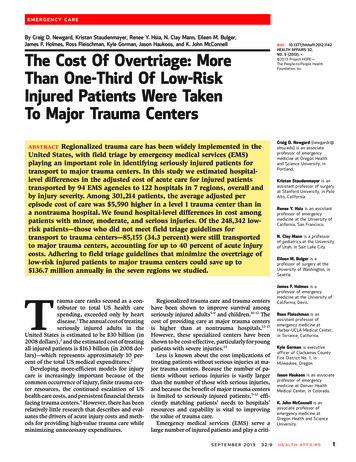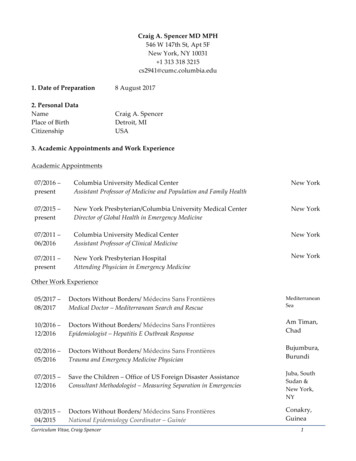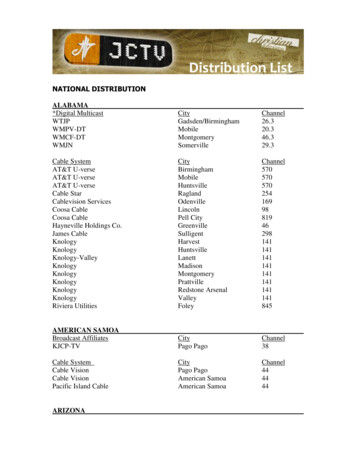
Transcription
Emergency CareBy Craig D. Newgard, Kristan Staudenmayer, Renee Y. Hsia, N. Clay Mann, Eileen M. Bulger,James F. Holmes, Ross Fleischman, Kyle Gorman, Jason Haukoos, and K. John McConnell10.1377/hlthaff.2012.1142HEALTH AFFAIRS 32,NO. 9 (2013): – 2013 Project HOPE—The People-to-People HealthFoundation, Inc.doi:The Cost Of Overtriage: MoreThan One-Third Of Low-RiskInjured Patients Were TakenTo Major Trauma CentersRegionalized trauma care has been widely implemented in theUnited States, with field triage by emergency medical services (EMS)playing an important role in identifying seriously injured patients fortransport to major trauma centers. In this study we estimated hospitallevel differences in the adjusted cost of acute care for injured patientstransported by 94 EMS agencies to 122 hospitals in 7 regions, overall andby injury severity. Among 301,214 patients, the average adjusted perepisode cost of care was 5,590 higher in a level 1 trauma center than ina nontrauma hospital. We found hospital-level differences in cost amongpatients with minor, moderate, and serious injuries. Of the 248,342 lowrisk patients—those who did not meet field triage guidelines fortransport to trauma centers—85,155 (34.3 percent) were still transportedto major trauma centers, accounting for up to 40 percent of acute injurycosts. Adhering to field triage guidelines that minimize the overtriage oflow-risk injured patients to major trauma centers could save up to 136.7 million annually in the seven regions we studied.ABSTRACTTrauma care ranks second as a contributor to total US health carespending, exceeded only by heartdisease.1 The annual cost of treatingseriously injured adults in theUnited States is estimated to be 30 billion (in2008 dollars),2 and the estimated cost of treatingall injured patients is 163 billion (in 2008 dollars)—which represents approximately 10 percent of the total US medical expenditures.3Developing more-efficient models for injurycare is increasingly important because of thecommon occurrence of injury, finite trauma center resources, the continued escalation of UShealth care costs, and persistent financial threatsfacing trauma centers.4 However, there has beenrelatively little research that describes and evaluates the drivers of acute injury costs and methods for providing high-value trauma care whileminimizing unnecessary expenditures.Regionalized trauma care and trauma centershave been shown to improve survival amongseriously injured adults5–9 and children.10–12 Thecost of providing care at major trauma centersis higher than at nontrauma hospitals.13–15However, these specialized centers have beenshown to be cost-effective, particularly for youngpatients with severe injuries.13Less is known about the cost implications oftreating patients without serious injuries at major trauma centers. Because the number of patients without serious injuries is vastly largerthan the number of those with serious injuries,and because the benefit of major trauma centersis limited to seriously injured patients,5–12 efficiently matching patients’ needs to hospitals’resources and capability is vital to improvingthe value of trauma care.Emergency medical services (EMS) serve alarge number of injured patients and play a critiS EP T E M B E R 20 1 332 : 9Craig D. Newgard (newgardc@ohsu.edu) is an associateprofessor of emergencymedicine at Oregon Healthand Science University, inPortland.Kristan Staudenmayer is anassistant professor of surgeryat Stanford University, in PaloAlto, California.Renee Y. Hsia is an assistantprofessor of emergencymedicine at the University ofCalifornia, San Francisco.N. Clay Mann is a professorof pediatrics at the Universityof Utah, in Salt Lake City.Eileen M. Bulger is aprofessor of surgery at theUniversity of Washington, inSeattle.James F. Holmes is aprofessor of emergencymedicine at the University ofCalifornia, Davis.Ross Fleischman is anassistant professor ofemergency medicine atHarbor-UCLA Medical Center,in Torrance, California.Kyle Gorman is executiveofficer of Clackamas CountyFire District No. 1, inMilwaukee, Oregon.Jason Haukoos is an associateprofessor of emergencymedicine at Denver HealthMedical Center, in Colorado.K. John McConnell is anassociate professor ofemergency medicine atOregon Health and ScienceUniversity.Health Affairs1
Emergency Carecal role in directing seriously injured patients tomajor trauma centers. Because serious injuriesmay not be immediately apparent, and becausetransporting all injured patients to major traumacenters would quickly overwhelm trauma resources, most US EMS and trauma systems usenational field triage guidelines to identify seriously injured patients for transport to majortrauma centers. Originally developed in 1987,the triage guidelines have been periodically revised based on new research16,17 and are widelyimplemented by EMS agencies throughout theUnited States.Undertriage (transporting seriously injuredpatients to nontrauma centers) and overtriage(transporting patients without serious injuriesto major trauma centers) represent mismatchesbetween need and capability and are importantproblems in trauma systems that must be addressed.18 Because it is not realistic to markedlyreduce both under- and overtriage,19 the prevailing philosophy in the United States has beento minimize undertriage (with the goal of subjecting no more than 5 percent of cases to undertriage) instead of overtriage (the current goal isno more than 50 percent of cases).18 Nonetheless, the development and implementation offield triage guidelines are modifiable aspects ofthe health care delivery system.In this study we sought to compare the adjusted total cost of acute injury care—that is, EMS,emergency department (ED), and hospital admission costs—by hospital type and injury severity among a broad cohort of injured patientstransported by EMS to acute care hospitals inseven regions of the western United States. Wealso evaluated the potential cost savings thatwould accrue from eliminating overtriage—transporting low-risk injured patients to majortrauma centers.Study Data And MethodsDesign This was a multiregion, populationbased, retrospective cohort study. Sixteen Institutional Review Boards in the seven regions involved approved this protocol and waived therequirement for informed consent.Setting The study included injured childrenand adults evaluated by ninety-four EMS agencies and transported to 122 hospitals (15 level 1trauma centers, 8 level 2 trauma centers, and 99nontrauma centers) in seven regions across thewestern United States from January 1, 2006,through December 31, 2008. The regions werePortland, Oregon, and Vancouver, Washington(four counties); King County, Washington;Sacramento, California (two counties); SanFrancisco, California; Santa Clara, California2Health A ffairsSEPTEMBER 201332:9(two counties); Salt Lake City, Utah (fourcounties); and Denver County, Colorado. Eachregion had a predefined geographic “footprint,”including a central metropolitan area and surrounding suburban and rural areas defined byEMS agency service areas. All of the regionshad established trauma systems with designatedmajor trauma centers.The process of field triage in these traumasystems is guided by the national guidelinesand is intended to identify seriously injured patients in need of immediate transport to majortrauma centers. The guidelines consist of twentyfour criteria organized into a four-step algorithm(physiologic, anatomic, mechanism, and specialconsiderations “steps”).17After responding to a 911 call about an injuredpatient, EMS providers typically make the triagedecision based on criteria represented in the algorithm, including the use of their own judgment.20 When an EMS provider determines thatan injured patient meets one or more of the fieldtriage criteria (these cases are called field traumaactivations in this article), the patient is triagedto the ED of a major (level 1 or 2) trauma center.Such centers provide tertiary trauma services—including twenty-four-hour availability of a trauma surgeon and specialists such as a neurosurgeon, surgical critical care, and the use oftrauma-specific quality assurance processes—that are all required to care effectively for patients with the most complex trauma conditions.18 Injured patients who do not meet triagecriteria (cases called nonfield activations or triagenegative cases here) may be transported to an EDbased on patient choice, proximity, ambulancediversion status, and other factors.20,21Patient Population The study sample included all injured patients for whom the 911EMS system was activated within the seven predefined geographic regions and for whom thecall resulted in transport to an acute care hospital (either a trauma center or not). The sampleincluded patients with minor, moderate, andserious injuries.Injured patients arriving at hospitals by meansother than EMS (such as walk-in patients andthose who came by private automobile) wereexcluded from the sample, as were interhospitaltransfers without an initial presentation involving EMS. However, we did track subsequentinterhospital transfers following the initialEMS transport for patients in the sample. Wealso excluded EMS calls with no patient contactand patients who were not transported—for example, those who refused transport or who diedbefore they could be transported.Data Processing And Database Development To construct the sample, each participat-
Undertriage andovertriage representmismatches betweenneed and capabilityand are importantproblems in traumasystems.ing EMS agency transmitted its electronic patient care reports to a central data coordinatingcenter. In regions where multiple EMS agencies(such as fire departments and private ambulanceagencies) care for the same patients, we matchedEMS records at the patient level. We thenmatched EMS records to hospital records in trauma registries, state hospital discharge databases(for admitted patients), and state ED databases(for patients not admitted to a hospital) throughprobabilistic linkage.We used LinkSolv software,version 8.2.The development of our database has beenpreviously described,22 including the validationof all-electronic data collection processes.23 Therecord linkage methodology has been validatedfor matching ambulance records to trauma registry data24 and rigorously evaluated in this database.22 In Appendix Exhibits 1 and 2, we detailhow we constructed the database and sample.25Variables We used a comprehensive approach to identify field trauma activations, including a specific mention of trauma triagecriteria in the EMS patient care report; documentation of field trauma activation (or similarwording, depending on local terminology) bythe EMS provider; an EMS-recorded traumaidentification number (used in some regionsas a mechanism for tracking injured patientswho enter a trauma system); a matched recordfrom the local trauma registry specifying EMSfield trauma activation; and transcribed phonerecords from regions where EMS personnelmust call ahead to the trauma center before arriving with field trauma activation patients. Allother patients were considered triage negative.Trauma activation status was considered independent of the type of hospital to which thepatient was transported.We collected additional variables through EMSand hospital charts. These variables includedpatients’ demographic characteristics, insurance status, out-of-hospital physiologic measures, mechanism of injury, out-of-hospitalprocedures, transport mode (ground versushelicopter), injury severity measures (describedbelow), surgical interventions, blood transfusions, hospital length-of-stay, in-hospital mortality, and cost (also described below). Additional variables were hospital type and whether ornot there was an interhospital transfer.Acute care hospitals were categorized by trauma center level (level 1, level 2, or nontraumacenter), based on their American College ofSurgeons accreditation status and state-leveldesignations. For purposes of this analysis, wecoded hospital type on the basis of final destination to represent the type of facility in whichpatients received the majority of their care.Injury severity measures were not collected instate discharge or ED databases. Therefore,we used International Classification of Diseases,Ninth Revision, Clinical Modification (ICD-9CM), codes and the ICDPIC mapping functionin the statistical analysis software Stata, version11,26 to convert diagnosis codes to Injury SeverityScore27 (ISS) and ICD-9-CM-based InjurySeverity Score (ICISS) values. Previous studieshave validated the process of mapping administrative diagnosis codes to generate anatomicinjury scores.28,29 In addition, we have previouslyvalidated ICDPIC-generated injury scoresagainst chart-abstracted scores in our database.30We defined injury severity categories using ISS27as follows: serious injury is ISS 16; moderateinjury is ISS 9–15; and minor injury is ISS 0–8.Outcome The primary outcome was totalacute care cost.We evaluated the cost per patientbased on the following four sources of acute careexpenses: initial EMS transport from the sceneof the injury; ED care; hospitalization (for admitted patients); and interhospital transfer, including the cost of initial ED evaluation andEMS interhospital transport. We estimated theper unit cost of ambulance transport from a separate sample of injured Medicare fee-for-servicepatients transported by EMS in Oregon andWashington. We obtained patient-level ED andin-hospital facility charges for all patients withlinked hospital records.ED and hospital charges were converted tocosts using hospital- and year-specific cost-tocharge ratios.31,32 We estimated professional feesfrom facility costs by applying a conversion factor (1.27) that had previously been calculatedfor injured patients using the Truven HealthAnalytics MarketScan database.13 For patientsrequiring an interhospital transfer, we estimatedthe per unit cost of the initial ED evaluation andEMS interhospital transport, using the previousS EP T E M B E R 2 0 1 332 : 9Health Affairs3
Emergency Carely described Medicare fee-for-service sample.We did not evaluate costs beyond the acutecare period (for example, costs for postdischargefollow-up, outpatient visits, or rehabilitation)or costs related to loss of productivity or workdays. All costs were adjusted to 2008 US dollarsusing a region-specific medical Consumer PriceIndex.33Data Analysis The primary analysis includedall injured patients transported by EMS in theseven regions, whether or not a hospital recordcould be linked to the EMS record. This strategypreserved the population-based sampling designand minimized bias in the analysis.We used multiple imputation34 through flexible chains regression models35 to handle missing values.Adjusted estimates for total costs were generated using multivariable generalized linear models with a gamma distribution and log link function to fit the positively skewed distribution ofcosts.36–38 To assess the robustness of our findings, we compared our primary results with sensitivity analyses using the nonimputed data set(the complete case analysis) and truncated versus nontruncated costs. Details regarding recordlinkage, imputation, and cost analyses are presented in Appendix Exhibit 3.25Limitations This study had important limitations. It was not designed as a cost-effectivenessanalysis, and we did not evaluate patient outcomes. The cost-effectiveness of trauma carehas previously been demonstrated.13A central premise in this study is that onlypatients with serious injuries benefit from carein major trauma centers. Although this assumption is supported by many previous studies,5–12most research demonstrating the benefit of trauma centers and trauma systems has focused onsurvival. There may be other benefits of majortrauma centers for less seriously injured patientsthat are difficult to quantify (for example, fewercomplications, missed diagnoses, and errors).Whether these potential benefits justify the increased costs of providing care in major traumacenters for patients without serious injuries remains unclear.Other potential limitations include the characteristics of the study sample and unmeasuredconfounding.We did not include injured patientswho did not use the 911 EMS system. Therefore,our findings apply only to injured patients transported by EMS and thus underestimate the totalcost of acute injury care. Also, the use of a helicopter can increase costs in a trauma system.39However, a relatively small proportion of patients in our sample were transported by helicopter.If sicker patients tended to be transported tospecific types of hospitals (such as level 1 trauma4Health AffairsSEPTEMBER 201332:9The downstream costsof transporting lowrisk patients to majortrauma centers aresubstantial.centers) and the observed variables did notcompletely explain that fact, such unmeasuredconfounding could have inflated the cost differences. We used several analytic strategies to account for confounding, and we used sensitivityanalyses to assess the robustness of our results.Our cost estimates were similar to15 or more conservative than13 those in previous studies.The cost analyses involved several assumptions, including the accuracy of using cost-tocharge ratios, per unit cost estimates for EMStransport, and a ratio to calculate professionalfees from facility costs. Although there is potential for error with each of these steps, inclusion ofall of these costs presents a more representativepicture of total costs.Furthermore, our data did not produce directinsights into why costs are higher at major trauma centers. For example, it is not clear if theexplanation is that such centers have greaterfixed resources to maintain, use cost shiftingto account for higher rates of uncompensatedcare, make greater use of diagnostic testingand technology, or support education and research missions.Our estimates for cost savings also assumedthat nontrauma hospitals could handle largerpatient volumes and navigate the obstacles ofproviding the on-call coverage40 that would berequired to care for a wider variety of injuredpatients. In addition, actualizing the cost savingsassumed that modifying ambulance transportprotocols would not keep EMS personnel andvehicles out of commission longer than theyare at present, and that trauma centers couldsurvive with less revenue.Study ResultsCharacteristics Of Sample And TriageProcesses During the three-year study period,301,214 injured patients were transported byninety-four EMS agencies to 122 hospitals inthe seven regions, resulting in total estimatedacute care costs of more than 1.01 billion. Of
those patients, 12,382 (4.1 percent) had seriousinjuries, 31,170 (10.4 percent) had moderate injuries, and 257,662 (85.5 percent) had minorinjuries (Exhibit 1).Within the study population there were 52,872(17.6 percent) field trauma activations. Fieldtrauma activations identified 7,209 (58.2 percent) of the 12,382 seriously injured patients.In total, 7,686 (62.1 percent) patients with serious injuries were transported to major traumacenters—including patients identified by triageguidelines and those transported to traumacenters for other reasons—resulting in 37.9 percent undertriage.Of the 288,832 patients with minor or moderate injuries, 119,823 (41.5 percent) received careat major trauma centers (92,016 patients atlevel 1 and 27,807 patients at level 2 centers).Although patients without serious injuriestreated at major trauma centers are typicallyconsidered overtriaged, the extent and seriousness of injuries are generally not known at thetime of EMS evaluation. To provide a more realistic perspective, there were 248,342 low-riskpatients identified by field triage guidelines, ofwhom 85,155 (34.3 percent) were transported(overtriaged) to major trauma centers.Regional Characteristics And CostsCharacteristics of the study regions and region-specific costs are detailed in AppendixExhibit 4.25 The region-specific adjusted perpatient cost of acute injury care ranged from 4,480 to 12,114, with an average cost of 9,651. Estimates of per capita injury costs—thatis, the cost of acute injury care averaged acrossthe population served—ranged from 29 to 283.Cost Differences By Hospital Type Therewere substantive differences in adjusted costs byhospital type, with patients who received care atlevel 1 trauma centers incurring the largest average cost (Exhibit 2). Detailed results from theregression analysis are provided in AppendixExhibit 5.25Cost Differences By Hospital Type AndInjury Severity When patients were stratifiedby injury severity, the cost differences betweendifferent types of hospitals persisted (Exhibit 3).Level 1 trauma centers had the highest adjustedcosts per patient across all injury strata. Amongpatients with minor injuries, for example, theadjusted cost of treatment at level 1 centerswas 2,467 (95% confidence interval: 2,285, 2,650) higher than at level 2 centers and 4,833 (95% CI: 4,649, 5,017) higher thanat nontrauma hospitals. Detailed results fromthe regression model are provided in AppendixExhibit 6.25Costs For Patients Not Meeting FieldExhibit 1Characteristics Of Injured Patients In The Study Sample Transported By Emergency MedicalServices 809145,18811.854.134.148.2Initial SBP 90 mmHgInitial GCS 8Intubation attemptIntravenous line placement8,5364,9882,13691,2542.81.70.730.3Field triage status1 or more field triage 04,44785.510.44.14.021.71.5Demographic characteristicsAge (years)aUnder 1818–5455 or olderFemalePrehospital physiology and proceduresMechanism of injuryGunshot woundStabbingAssaultFallMotor vehicle crashOtherEMS transportAir medical scene transportInterhospital transferHospital type (final destination)Level 1 trauma centerLevel 2 trauma centerNontrauma centerOutcomeISSb0–89–15 16Major nonorthopedic surgerycOrthopedic surgeryIn-hospital mortalitySOURCE Authors’ analysis of the study data. NOTES N ¼ 301; 214 patients. SBP is systolic bloodpressure. GCS is Glasgow Coma Scale. See Sternbach GL. The Glasgow coma scale. J Emerg Med.2000;19(1):67–71. aMean age is 45.7 years. bISS is Injury Severity Score (see Note 27 in text).Mean ISS is 4.4. 0–8 is minor injury, 9–15 is moderate injury, and 16 is serious injury. cBrain,spine, neck, thorax, abdomen, interventional radiology, or vascular operative procedures duringhospitalization.Trauma Triage Criteria Of the 248,342 patients identified as low risk by field triage guidelines, 243,169 (97.9 percent) were not seriouslyinjured. However, 85,155 of the patients identified as low risk (34.3 percent) were overtriaged(64,382 being transported to level 1 trauma centers and 20,773 to level 2 centers).We estimated the cost savings that could beachieved by using five different scenarios for redirecting such overtriaged patients to lower-levelcenters (Exhibit 4). To test the robustness ofthese estimates, we recalculated cost savings using only nonfield activations. Under the five sceS EP T E M B E R 2 0 1 332 : 9Health Affairs5
Emergency CareExhibit 2Average Adjusted Total Cost Per Patient In The Study Sample, By Hospital LevelSOURCE Authors’ analysis of the study data. NOTES N ¼ 301; 214 patients. Covariates in the multivariable generalized linear model were hospital type (level 1, level 2, or nontrauma center); age; sex;mechanism of injury (fifteen categories); field triage status (positive or negative); need for fieldventilation (intubation or bag-valve mask ventilation); IV placement; Glasgow Coma Scale (seeExhibit 1 Notes); systolic blood pressure 90 mmHg; Injury Severity Score (see Note 27 in text);Injury Severity Score based on International Classification of Diseases, Ninth Revision, ClinicalModification (ICD-9-CM), codes; and need for major nonorthopedic surgery, orthopedic surgery, bloodtransfusion, or interhospital transfer. The numbers above the brackets represent the difference inadjusted estimated per patient cost between the levels of hospitals, including 95% confidenceintervals (CI).narios, estimated cost savings ranged from3.8 percent to 40.6 percent of total acute carecosts. Redirecting all nonfield activations previously transported to level 1 and level 2 traumacenters to nontrauma centers instead was associated with the largest cost savings.Sensitivity Analyses To test the validity androbustness of our models, we conducted severalsensitivity analyses. To assess model fit, we compared actual costs to predicted costs, whichyielded similar values ( 9,651 versus 10,090,respectively). Across the majority of comparisons, estimated cost savings were lower whenwe used multiple imputation in comparison toa nonimputed sample (Appendix Exhibit 7).25Cost data were more likely to be missing forpatients not admitted to a hospital (a populationwith both less severe injuries and lower expectedcosts), compared to admitted patients. Thus, thesensitivity analyses suggested that results fromthe multiply imputed data set were preferred,and we retained them for our primary results.DiscussionThis study demonstrates that among injured patients transported by EMS, the cost of acute carediffers substantially by the type of hospital toExhibit 3Average Adjusted Total Cost Per Patient In The Study Sample, By Injury SeveritySOURCE Authors’ analysis of the study data. NOTES N ¼ 301; 214 patients. Covariates in the multivariable generalized linear modelwere combined Injury Severity Score (see Note 27 in text) and hospital type (nine categories); age; sex; mechanism of injury (fifteencategories); need for field ventilation (intubation or bag-valve mask ventilation); IV placement; Glasgow Coma Scale (see Exhibit 1Notes); systolic blood pressure 90 mmHg; Injury Severity Score based on International Classification of Diseases, NinthRevision, Clinical Modification (ICD-9-CM), codes; and need for major nonorthopedic surgery, orthopedic surgery, blood transfusion,or interhospital transfer. The numbers above the brackets represent the difference in adjusted estimated per patient cost between thelevels of hospitals, including 95% confidence intervals (CI).6H ea lt h A f fai r sSE PT EM B E R 2 01 332:9
Exhibit 4Estimated Annual Cost Savings, By Scenarios Of Changes In Emergency Medical Services (EMS) Transport Patterns For Patients Not Meeting National FieldTriage GuidelinesAnnual savings in study regionsUsing full study sample forestimatesUsing only nonfield activationsfor estimatesScenarioDollars% of acutecare costsDollars% of acutecare costs1: All nonfield activations transported to nontrauma centers2: Nonfield activations previously transported to level 1 trauma centerstransported to level 2 860,118,62517.83: Nonfield activations previously transported to level 1 trauma centerstransported to nontrauma centers118,234,11035.1100,593,44229.94: Nonfield activations previously transported to level 2 trauma centerstransported to nontrauma centers18,484,8005.512,772,2253.85: 50% of nonfield activations previously transported to level 1 or 2 traumacenters transported to nontrauma centers67,353,87520.055,677,25416.5SOURCE Authors’ analysis of the study data. NOTES “Nonfield activations” are injured patients who do not meet the criteria in the national field triage guidelines (seeNote 17 in text). Cost savings were estimated from average adjusted cost differences by trauma center type (level 1, level 2, and nontrauma centers) after costs ofinterhospital transfer (including initial emergency department evaluation) for undertriaged patients (those with severe injuries originally transported to nontraumacenters) were accounted for.which a patient is transported. This finding remained consistent after we accounted for severity of injury and multiple important confounders.We also found that the downstream costs oftransporting low-risk patients to major traumacenters—such as the costs of inpatient hospitalservices—are substantial, particularly for level 1centers. These results suggest that EMS fieldtriage decisions have large cost implications. Ifhealth systems matched patients’ needs moreappropriately to hospitals’ capabilities, costscould be reduced. Our study also demonstratesvariability in per patient and per capita injurycosts across regions, which may further contribute to excess acute care costs.Previous research has shown that adjustedcosts are higher at major trauma centers thanat nontrauma hospitals.13–15 However, past studies have primarily focused on patients with serious injuries. One exception is a recent studysuggesting that implementing updated field triage guidelines could result in a national savingsof 568 million annually by reducing overtriage.41 We found similar results among a broad,population-based sample of injured patientstransported by EMS to acute care hospitals.Focusing on patients served through the 911EMS system is important because EMS plays anintegral role both in concentrating seriously injured patients at major trauma centers (throughfield triage) and in selecting the location of hospital care. The benefit of major trauma centersappears limited to patients with serious injuries.5–12 Thus, the combination of higher costsand treating a large number of patients whoare not seriously injured at major trauma centersresults in an expensive mismatch of hospitals’capabilities to patients’ needs without measurable benefit. Although it is possible that certainpatients with minor to moderate injuries haveimproved outcomes in trauma centers, thesebenefits have not yet been demonstrated.Our estimates for cost savings provide insightsinto aspects of trauma systems that could bemodified to save costs. Because it would be impossible to avoid all overtriage—transporti
HEALTH AFFAIRS 32, NO. 9 (2013):- 2013 Project HOPE— The People-to-People Health Foundation, Inc. Craig D. Newgard(newgardc@ ohsu.edu) is an associate professor of emergency medicine at Oregon Health and Science University, in Portland. Kristan Staudenmayeris an assistant professor of surgery at Stanford University, in Palo Alto, California.










